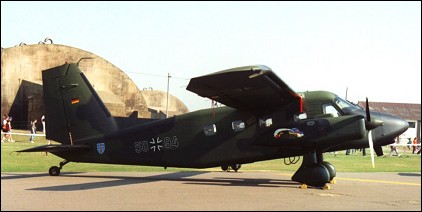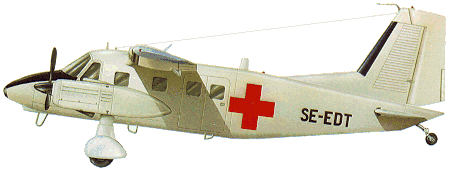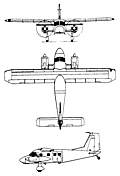 |
Dornier Do 28D / Do 128 Skyservant1966 |  |
| TRANSPORT | Virtual Aircraft Museum / Germany / Dornier |
 |
While the original Do 28 series had an advantage over the Do 27 by providing twin-engine safety and enhanced performance, it did not have any more internal space, the cabin dimensions being identical to those of its predecessor. Financial assistance provided by the German Ministry of Economics helped Dornier to develop the layout into a bulkier, higher-powered STOL transport which could carry up to 13 passengers and this redesigned version was designated Dornier Do 28D, later being named Skyservant. The redesign was so drasticthat, apart from the layout and designation, the Do 28D bore little resemblance to the Do 28B. The prototype flew on 23 February 1966, receiving type approval a year later. Developed as the Do 28D-1, the type won FAA certification on 19 April 1968 and military type approval in January 1970. Orders for 125 were placed for the German Luftwaffe and Bundesmarine, and other military deliveries have been made to Ethiopia, Morocco, Nigeria, Turkey and Zambia. More than 220 Skyservants are in operation world-wide. A Do 28D-1 set several class records for piston-engined business aircraft in 1972, including an altitude of 8624m with a 1000kg payload, as well as several time-to-height records. It was followed by the Do 28D-2, which introduced a number of refinements, and in 1980, a Luftwaffe Do 28D-2 was re-engined with Avco Lycoming TIGO-540 turbocharged engines under a contract from the German Federal Ministry of Defence prior to upgrading that country's military Skyservants; the new designation was Do 28D-2T. Further development of the basic Do 28D design continued under a new designation: Do 128 Skyservant. Two basic designs were offered, the Do 128-2 and Do 128-6. Both 10-passen-ger models, the main difference was in powerplant, the Do 128-2 having two Avco Lycoming IGSO-540 piston engines and the Do 128-6 two 298kW Pratt & Whitney PT6A-110 turboprops. The latter had first been seen in prototype form as the Do 28D-5X, known then as the TurboSky and powered by two 447kW Avco Lycoming LTP 101-600-1A turboprops flat-rated to 298kW. The Do 128-6 had, in addition, a new fuel tank, reinforcements to the underwing engine supports and other modifications. Orders and options for 30 Do 128-6s from African customers were announced, the first going to Lesotho Airways. A variant of the Do 128-6 was also delivered to Cameroun for maritime patrol work, equipped with a 360° MEL Marec surveillance radar. Production ceased in the mid-1980s.

|  COMPANY PROFILE | |||||||||||||||||||||||||||||||||||||||||||||||||||||||||
 |

|

